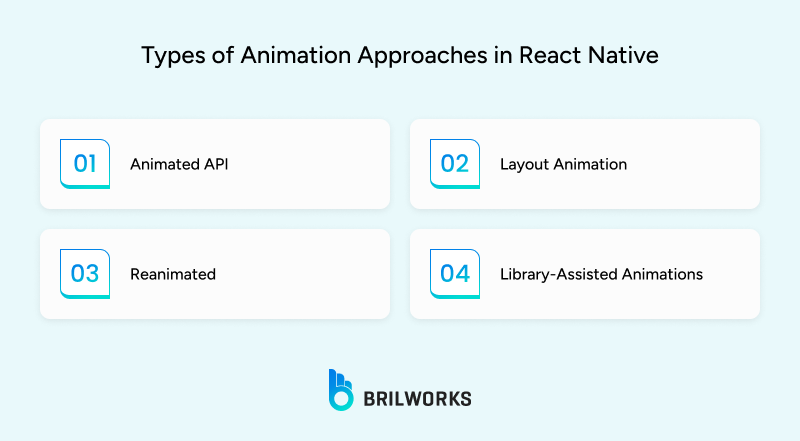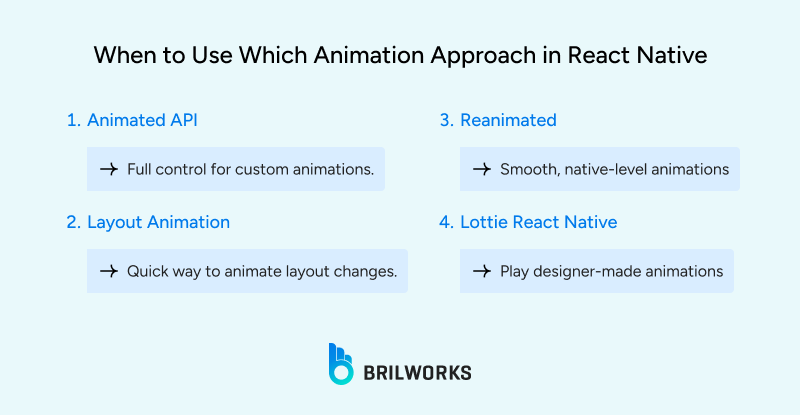COOPERATION MODEL
ARTIFICIAL INTELLIGENCE
PRODUCT ENGINEERING
DevOps & Cloud
LOW-CODE/NO-CODE DEVELOPMENT
INDUSTRY
FRONTEND DEVELOPMENT
CLOUD DEVELOPMENT
MOBILE APP DEVELOPMENT
LOW CODE/ NO CODE DEVELOPMENT
EMERGING TECHNOLOGIES








Animations make an app feel easier to use. They help you notice changes on the screen and understand what just happened. Without them, screens can switch too suddenly and the flow can feel broken. React Native animations give you a way to add these movements without slowing the app down. They might be a quick fade in for text or a few elements moving together when a new screen loads.
React Native has built in options for animations and there are also libraries that give you more control. Some are simple and good for small changes. Others are better when you need complex effects or smoother transitions. The choice depends on what you are building and how you want it to behave.
This guide will walk you through the main options for animations in React Native. You will see how they work, where they are useful, and how to keep them running smoothly. There will be examples you can try and some common mistakes to watch out for so your animations feel right on any device.

Animations make an app feel smoother and easier to follow, a quality seen in many popular apps built with React Native. They help connect what a user does with what happens on the screen. With animations in react native app development, changes feel natural instead of sudden, which keeps the flow of the app steady.
When something moves in a smooth way, it feels easier to follow. A menu that slides in feels more comfortable than one that just appears. A card that fades out tells the user it is gone without any confusion. Little movements like this keep the experience simple and clear.
Animations can quietly point people in the right direction. A button can shake a little when something needs fixing. A loading bar can move steadily so the user knows progress is happening. These cues work without needing extra text or instructions.
When screens slide or fade into each other, the user can see the connection between them. It feels like moving through one space instead of jumping between separate pages. This makes navigation feel natural, delivering consistent cross-platform experiences.
Animations do more than just make an app look nice. They make actions easier to understand, give feedback without words, and help the app feel simple to use.

React Native supports multiple ways to implement animations, each with its own strengths and best use cases. Choosing the right one depends on the complexity of your design, the level of control you need, and performance considerations. Here’s a breakdown of the most common approaches, leveraging the framework’s strengths.
The Animated API is the built-in solution for creating dynamic and flexible animations. It gives you fine control over animated values, timing, and easing, making it ideal for complex transitions or highly interactive elements. You can chain animations together, run them in sequence, or trigger them in response to user gestures.
Runs animations on the JavaScript thread by default
Supports interpolation to map input values to output ranges
Works for styles like opacity, scale, rotation, and position
Can combine multiple animations for more complex effects
LayoutAnimation is the simplest way to add polish to your UI when layout changes occur. Instead of manually defining animations, it automatically animates elements as they change position or size in the layout. This makes it perfect for scenarios like expanding cards, reordering lists, or animating between screen states without extra configuration.
Automatically detects layout changes and animates them
No need to manually set animated values
Great for list reordering, collapsible menus, and responsive layouts
Limited control compared to the Animated API
Reanimated is a popular third-party library built for smoother and more performant animations, especially in gesture-heavy apps. Unlike the default Animated API, it runs animations on the UI thread, preventing frame drops even when the JavaScript thread is busy. This makes it the go-to choice for fluid, high-performance interactions.
Runs animations on the UI thread for better performance
Ideal for gesture-based interactions like swipes and drags
Supports complex physics-based animations
Reduces lag and improves frame consistency in demanding apps
Library-assisted animation approaches use specialized tools and frameworks that simplify complex animation logic. These libraries often provide prebuilt effects, reusable motion components, and integration with design assets, which can significantly speed up development. They are especially useful when you want high-quality visuals without reinventing the wheel, especially with React Native UI libraries.
Includes tools like Lottie React Native, React Native Animatable, and Moti
Offers prebuilt transitions, micro-interactions, and animated components
Can integrate directly with exported animations from design tools like After Effects
Saves time for developers by reducing manual coding for animations
The Animated API is React Native’s native tool for building smooth, customizable animations. It works by creating animated values that can be linked to style properties, allowing you to change them over time using different animation types. This gives you fine-grained control over transitions, gestures, and complex motion effects without relying on external libraries, supported by helpful development toolkits.
To start using it, you typically follow three main steps:
Create an Animated Value – This is a special object that holds the value you want to animate, such as position, scale, or opacity.
Define an Animation – Use helpers like Animated.timing, Animated.spring, or Animated.decay to specify how the value should change over time.
Apply the Animation – Bind the animated value to a style property of an Animated.View or Animated.Text so it updates visually as the animation runs.
import React, { useRef, useEffect } from 'react';
import { Animated, View, StyleSheet } from 'react-native';
export default function FadeInView() {
const fadeAnim = useRef(new Animated.Value(0)).current; // Initial opacity is 0
useEffect(() => {
Animated.timing(fadeAnim, {
toValue: 1,
duration: 1000,
useNativeDriver: true
}).start();
}, [fadeAnim]);
return (
<Animated.View style={[styles.box, { opacity: fadeAnim }]} />
);
}
const styles = StyleSheet.create({
box: {
width: 100,
height: 100,
backgroundColor: 'tomato'
}
});Always wrap the target element with an Animated component like Animated.View or Animated.Text
Choose the right animation type (timing, spring, decay) based on the motion effect you want
Use useNativeDriver: true for better performance on supported properties
Chain animations together using Animated.sequence or run them in parallel with Animated.parallel
LayoutAnimation is a built-in API in React Native that helps you animate layout changes without managing every single animation step. When the layout of a component changes, LayoutAnimation applies a transition so the change feels smooth instead of abrupt.
It works by applying an animation whenever a change occurs in the position or size of a component. This means you do not need to manually handle each property. Once you enable it, React Native automatically detects changes in the layout and animates them for you.
One common example is animating a list item when it is added or removed. Without LayoutAnimation, the new item would simply appear or disappear instantly. With it, the item slides or fades into place.
Here are a few ways LayoutAnimation can be used effectively
Adding or removing items in a list without sudden jumps
Expanding and collapsing sections in a view
Adjusting UI components when screen orientation changes
Creating smooth reordering effects for draggable elements
import React, { useState } from 'react';
import { View, Button, LayoutAnimation, StyleSheet } from 'react-native';
export default function App() {
const [size, setSize] = useState(100);
const changeSize = () => {
LayoutAnimation.configureNext(LayoutAnimation.Presets.easeInEaseOut);
setSize(size === 100 ? 200 : 100);
};
return (
<View style={styles.container}>
<View style={[styles.box, { width: size, height: size }]} />
<Button title="Toggle Size" onPress={changeSize} />
</View>
);
}
const styles = StyleSheet.create({
container: {
flex: 1,
justifyContent: 'center',
alignItems: 'center'
},
box: {
backgroundColor: 'tomato'
}
});In this example, every time the button is pressed, the box size changes with a smooth transition handled by LayoutAnimation.

Choosing the right animation method depends on what you are building and the level of control you need. Each approach has strengths and trade-offs.
Best for creating detailed and highly customizable animations. Use it when you need full control over timing, easing, and movement. It works well for complex UI effects like draggable elements or smooth motion on user gestures. Keep in mind it can be verbose to write but offers precision.
Good for simple screen layout changes like expanding cards, showing or hiding sections, or rearranging elements. It automatically animates layout updates without much code. However, it is not suited for complex, interactive animations, though it works well when building an MVP where speed of delivery matters.
Useful when you want smooth, native-level performance with complex gestures or physics-based effects. It runs animations on the UI thread which avoids frame drops. Works best for interactive components such as swipeable cards or gesture-driven transitions.
Ideal for rendering pre-designed animations exported from After Effects. Great for splash screens, loading indicators, or decorative effects. The trade-off is you cannot fully customize the animation logic since it is prebuilt.
Animations in React Native can run on the JavaScript thread or the native driver. The native driver moves animation calculations to the native side, which means less work for the JavaScript thread and smoother results, along with other ways to boost app performance. It works best with properties like opacity and transform. Not all styles are supported, so it is important to check the React Native documentation before enabling it.
An animation runs many frames per second, so anything inside the loop is executed repeatedly. If you calculate complex values in there, it slows down rendering. Always prepare values or process data before starting the animation. This ensures the animation frames are light and fast to draw.
Every time a state change happens, React Native re-renders the affected components. If this happens during an animation, it can cause noticeable lag. Try to limit updates to only what is needed for the animation to run. Using refs or context for non-UI data can help avoid unnecessary re-renders.
It is easy to think your animations are smooth when testing on high performance devices. However, many users may have mid-range or older phones. Test your app on slower devices or throttled emulators. This helps you see if animations skip frames or lag under real-world conditions.
Changing layout properties like width, height, or margin forces the layout engine to recalculate positions for many elements. This is more expensive than using transform properties like translate, scale, or rotate. Whenever possible, design your animations to work with transforms instead of layout changes for better speed.
Animations can make a React Native app feel more engaging and easier to use. When done right, they improve how users interact with the interface without slowing down performance. The key is to choose the right animation approach, test often, and avoid unnecessary complexity, which becomes easier when following React Native best practices.
If your project needs more advanced animation work or you want expert guidance to make sure your app performs well across devices, it can help to hire React Native developers who understand both design and performance. Partnering with an experienced mobile app development company gives you access to the right skills and resources to bring your ideas to life, scaling for enterprise-grade needs, with smooth, reliable animations.
React Native animations are effects that make elements move, change size, or transform smoothly in an app. They improve user experience by providing visual feedback and making interactions feel more natural. These animations can be simple, like fading a button, or complex, like dragging cards across the screen.
For beginners, LayoutAnimation is the easiest to use because it automatically animates layout changes with minimal code. The Animated API is better for more control, letting you adjust timing, easing, and complex sequences, but it requires more setup and understanding of animated values.
Lottie React Native allows developers to run animations created in design tools like Adobe After Effects. It works with JSON files exported from these tools, making it easy to add detailed, high-quality animations such as splash screens, loading indicators, and icon effects without manually coding each frame.
To improve animation performance, use the native driver when possible so animations run on the UI thread. Keep calculations outside the animation loop, avoid unnecessary state updates during animation, and prefer transforms instead of layout changes. Testing on lower-end devices ensures smooth performance for all users.
Reanimated is ideal for complex, interactive animations that need high performance. It is especially useful for gesture-based effects, physics-driven motions, or animations that must remain smooth even when the JavaScript thread is busy. Using it ensures a fluid experience for users on both high-end and low-end devices.
Get In Touch
Contact us for your software development requirements
Get In Touch
Contact us for your software development requirements